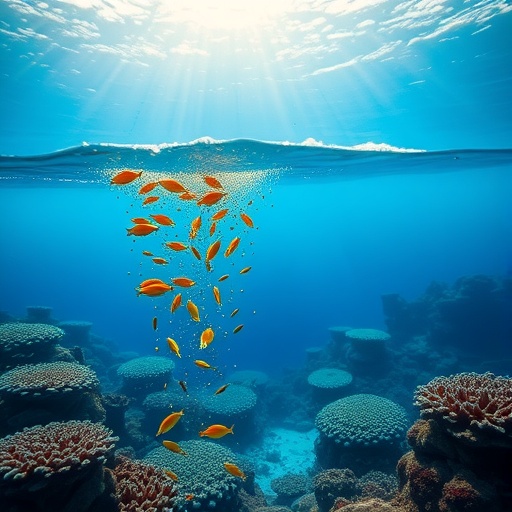In a groundbreaking study published in the journal Coral Reefs, researchers analyzed the intricate pathways of nutrient transfer within coral reef ecosystems, shedding light on mechanisms critical for the sustainability of these fragile environments. The research conducted by Dunn, Graham, Jeannot, and their team emphasizes the critical roles that both active and passive nutrient transfer modes play in supporting the ecological balance and health of coral reefs. With the gradual degradation of coral ecosystems worldwide, understanding these nutrient dynamics becomes paramount in ensuring the resilience of coral reefs amid ever-increasing anthropogenic pressures.
Coral reefs, often referred to as the rainforests of the sea, are complex ecosystems that host a plethora of marine life. They rely on a delicate balance of nutrients that are essential for their growth and survival. Nutrients such as nitrogen and phosphorus are crucial for phytoplankton and macroalgae, which serve as the foundational food source for numerous marine species. The study meticulously categorizes the ways in which these nutrients are transferred through the ecosystem, providing new insights into the interconnectedness of the various organisms inhabiting coral reefs.
Active nutrient transfer mechanisms involve the direct movement of nutrients between organisms through interactions such as predation, excretion, and symbiotic relationships. For instance, herbivorous fish grazing on algae serve not only to control algal growth but also facilitate the transfer of nutrients back into the water column through their waste products, creating a dynamic nutrient cycling system. This phenomenon underscores the importance of maintaining healthy fish populations within coral reef ecosystems, as their presence is vital for nutrient replenishment.
Conversely, passive nutrient transfer operates through environmental processes, such as ocean currents and water movement, that allow nutrients to diffuse throughout the reef ecosystem. These passive dynamics often depend on variables like water temperature, salinity, and the physical structure of the reef itself. The researchers’ findings highlight how various environmental conditions can significantly alter the effectiveness of passive nutrient transfer, suggesting that environmental changes, whether natural or anthropogenic, may disrupt these vital processes.
One of the most concerning aspects highlighted in the study is the impact of climate change on nutrient dynamics in coral reefs. Rising sea temperatures and ocean acidification can affect both the active and passive pathways of nutrient transfer. For example, increased temperatures may lead to shifts in the behavior and distribution of herbivorous fish, ultimately impacting their grazing patterns and the subsequent nutrient recycling they facilitate. Understanding these implications allows researchers and conservationists to better predict how coral ecosystems will respond to ongoing environmental changes.
Through a comprehensive review of existing literature and new empirical data, the study draws connections between nutrient transfer pathways and broader ecological outcomes. For instance, it explores how disturbingly high levels of nutrient runoff from coastal development can lead to algal blooms that outcompete coral for space and resources. This phenomenon emphasizes the need for integrated coastal management strategies to minimize nutrient loading from terrestrial sources, which could otherwise jeopardize coral health.
The research not only contributes to ecological theory but also offers practical applications for coral reef conservation. By recognizing the dual role of active and passive nutrient transfer processes, marine ecologists can design more effective management strategies that factor in the complexities of nutrient dynamics within reef systems. This can include implementing marine protected areas that ensure the abundance of herbivorous fish, thus promoting nutrient recycling where it is most needed.
Robust data collection and innovative modeling techniques were employed in this study to trace the intricate networks of nutrient flow in coral reefs. Researchers utilized advanced biogeochemical models that simulate different scenarios of nutrient input and transfer, offering insights into how changes in one part of the ecosystem can resonate throughout the entire reef community. This holistic view is crucial for fostering a better understanding of the ecological roles various species play in maintaining the health of coral reefs.
As coral reefs face unprecedented challenges due to both climate change and human activities, understanding the nuances of nutrient transfer becomes increasingly critical. With this research providing a clearer picture of active versus passive pathways, scientists are better equipped to develop targeted conservation measures. Additionally, engaging local communities and stakeholders in these efforts will be essential, as they are often the most directly affected by changes in reef health and functioning.
This landmark research is a clarion call to global audiences, raising awareness about the dire state of coral reefs and the urgent need for immediate action. It serves as a reminder that conserving these ecosystems is not merely an environmental concern; it is intricately tied to the livelihoods of millions who depend on healthy coral reefs for food, income, and nourishment.
The collaboration among researchers from various disciplines—from marine biology and ecology to environmental science and policy—demonstrates that innovative solutions to complex environmental issues come from interdisciplinary approaches. As the scientific community galvanizes around this urgent topic, it is essential to disseminate these findings widely, ensuring that stakeholders at all levels are informed and engaged in protecting coral reefs.
Ultimately, the research led by Dunn and colleagues reinforces a message of hope. While the challenges facing coral reefs are indeed substantial, understanding the mechanisms that underlie their survival bolsters the foundation for actionable change. As we continue to uncover the depths of coral ecosystem functioning, the path forward becomes clearer: through informed conservation efforts, collaborative research initiatives, and community engagement, we can safeguard these vital ecosystems for generations to come.
Subject of Research: Nutrient transfer pathways in coral reef ecosystems
Article Title: Active and passive pathways of nutrient transfer in coral reef ecosystems
Article References:
Dunn, R.E., Graham, N.A.J., Jeannot, LL. et al. Active and passive pathways of nutrient transfer in coral reef ecosystems.
Coral Reefs 44, 1157–1170 (2025). https://doi.org/10.1007/s00338-025-02676-z
Image Credits: AI Generated
DOI: https://doi.org/10.1007/s00338-025-02676-z
Keywords: Coral reefs, nutrient transfer, ecosystem dynamics, active pathways, passive pathways, climate change, marine conservation, ecological balance.




